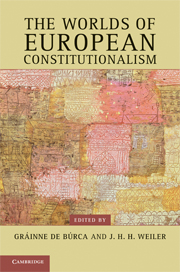Book contents
- Frontmatter
- Contents
- Contributors
- Introduction
- Prologue: global and pluralist constitutionalism – some doubts
- 1 The European Union as an international legal experiment
- 2 The place of European law
- 3 The ECJ and the international legal order
- 4 Local, global and plural constitutionalism
- 5 The case for pluralism in postnational law
- Dialogical epilogue
- Bibliography
- Index
1 - The European Union as an international legal experiment
Published online by Cambridge University Press: 05 June 2012
- Frontmatter
- Contents
- Contributors
- Introduction
- Prologue: global and pluralist constitutionalism – some doubts
- 1 The European Union as an international legal experiment
- 2 The place of European law
- 3 The ECJ and the international legal order
- 4 Local, global and plural constitutionalism
- 5 The case for pluralism in postnational law
- Dialogical epilogue
- Bibliography
- Index
Summary
Introduction
In a recent essay about legal theory and the European Union, Neil Walker wrote that theoretical inquiries about EU law as a whole – as opposed to studies of specific parts of EU law – ‘cannot but draw upon an arsenal of concepts and theoretical mechanisms developed or refined in an older context in which the national and the international, with the former dominating, were the two sides and the key frames of the world order of states’. This Chapter aims to replace the European Union in the ‘older context’ of international law, by recalling the fact that the European Communities, and the European Union, came into being as creatures of international law, as well as the fact that the many remarkable institutional features of those organisations came out of the existing toolbox of international law. Each of those single features had been experimented with before in other more limited contexts, but both the European Coal and Steel Community Treaty and the European Economic Community Treaty combined them in an unprecedented way. They were true experiments of international law, and the first part of the chapter will highlight some characteristics of that historical experimentation.
The more interesting question, perhaps, for today’s reader is whether this ‘arsenal of concepts and [. . .] mechanisms’ drawn from the toolbox of public international law is still of decisive importance for our understanding of European Union law today. There is no disputing the fact that ‘the EU has successfully expanded its substantive mandate and institutional prerogatives to a level without parallel among international organizations’, but there is some dispute about whether it is still situated ‘among international organizations’ or has ceased to belong to that category. In fact, the dominant strand in the EU law literature takes the view that the European Union, whilst not a federal state, is also no longer an international organization, but rather an ill-defined sui generis legal construct. In this chapter, I will question both the vagueness of the sui generis construction and the view that the EU is no longer an international organization (and thus no longer an ongoing international legal experiment) by wondering, in the second and third parts of the chapter, what could have happened in the course of time, between the 1950s and today, to make EU law cease to be part of international law despite its international treaty pedigree. I will address that question from two points of view. First (that is, in the second part of the chapter), I will examine the practice of the states, and especially the Member States of the EU, to explore whether they have willed, or consented to, such a change in the legal nature of the EU. In the third part of the chapter, I will turn to examine the case-law of the ECJ (European Court of Justice) and the doctrinal interpretations of that same question and consider two possibilities: either that particular novel characteristics of EU law emerged over time which are incompatible with seeing it as an international organization; or that the overall development of the EU, rather than the development of specific characteristics, justifies the view that it must no longer be considered as a living international legal experiment, but as something altogether different.
- Type
- Chapter
- Information
- The Worlds of European Constitutionalism , pp. 19 - 56Publisher: Cambridge University PressPrint publication year: 2011
- 14
- Cited by



